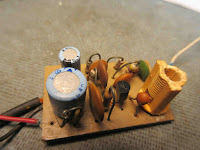In preparation for the demonstration at World of Commodore 2014, I found there were multiple bootstrap programs. It depended on hardware. The manual has two, a 21 byte and a 20 byte version. Over the course of a month, I studied the boot strap and tape in detail and found it really just loads another bootstrap program with better capabilities. It may seem that 20 bytes is not a lot, but there should be a warning in the manual "fingers will get sore after repeated use of the small switches on the ALTAIR". Further, each byte in turn lead to a greater probability of making an error.
The show went well, my friend Jeff Brown made a great video of the event "A re-tracing of how Paul Allen loaded BASIC on the MITS Altair 8800 from paper tape". I really must thank him for the idea of loading 4K BASIC! He saw my ALTAIR on a visit where we repaired his PET 2001 and suggested it. After he released his youtube video, I stumbled upon another video called "Bill Gates talks about Microsoft and the Altair 8800". At 3:26 into the video, Bill talks about the bootstrap loader and says Paul wrote the first loader in 46 bytes and he (Bill) later wrote it in 17 bytes. I thought to myself, yes, 17 bytes is better than 20 bytes... especially if you are repeatedly demonstrating it. I played with the idea of figuring out those 17 bytes then set out to make it as small as possible. Well, that's when I got it down to just 14 bytes and now down further (with some encouragement) to 12 bytes!
Last summer, I acquired a Teletype ASR33 in working condition and decided it was time return to World of Commodore 2016 with a smaller bootstrap loader. I narrowed what the bootstrap loader needs to work.
It needs to:
- initialize a memory pointer
- read a byte coming from the papertape
- load it to memory
- change the memory address
- loop back and repeat
- break out of this loop to execute the code
Octal
041 LXI H, ;Initialize Memory pointer to 0x01DB
333 IN 1 ;Read UART data register (skip the status register)
001
276 CMP M ;Compare with data stored at memory pointer
312 JZ 0001 ;Loop back if data is the same as stored
001
000
053 DCX H ;When it's a different byte, decrement the memory pointer
167 MOV M,A ;and save in memory
303 JMP 0001 ;Loop back for the next byte.
001
000
Now, you may notice, there's no way to break out of this loop, it will keep writing to memory until it overwrites itself... well that's great news!!! The bytes targeted to overwrite the jump will be 01 or 00. So, when the program finally gets overwritten the final jump will become JMP 0101 *OR* NOP
A long section of 00/01 is punched on the tape and these result in instructions that have no impact on program flow. Next there are some instructions that align the PC in an unambiguous way and finally a section of code that simply stores Bill's original bootstrap to 0000, waits for the "AE" leader as required, then branches to 0000 to continue with the original bootstrap.
Since the nuked jump can be to 0101, the program to load the program must be after that point, which is fine because the memory pointer starts as 01DB, which happen to be the instructions to input port 1.
Also, the boot strap program could be shorten even further, but only with a significant hardware modification to wait for bytes in hardware. The Tarbell 1101 Disk controller uses such a technique, hats off to Don Tarbell for a clever design!
That pretty much wraps up loading 4K basic with 5 bytes less than Bill. It should be noted... at 110 baud, the extra papertape takes more time than it would take to switch in the extra bytes. From start to finish, it takes about 9 minutes to load doing it Bill's way, and 10 minutes doing it my way. But my way takes only 1 minute at the switches, while Bill's way takes 2 minutes.
Sincerely,
Josh Bensadon
A friend sent me this picture... why does Bill look so concerned?
My friend Walter (right) and me at WoC 2016. ALTAIR and Teletype ASR33 in background.
My friend Jeff Brown (left) and me at WoC 2014.
Do two 8 bit machines stack up to a 16 bit machine?
-----------------------------------------------------------------------------------------------
The program to load the program on the papertape is....
Code to insert the original boot loader to 0000:
56 BYTES. (38h) Plus 3 (since JUMP 0203)
Puts lowest starting address at 023B.
DB 01 IN 01
FE AE CPI AE
C2 0201 JNZ 0102 LOOP BACK AND WAIT UNTIL TAPE LEADER
31 1400 LXI SP,0014
21 0300 LXI H,0003
E5 PUSH H
21 C0E9 LXI H,
E5 PUSH H
21 2D77 LXI H,
E5 PUSH H
21 BDC8 LXI H,
E5 PUSH H
21 DB01 LXI H,
E5 PUSH H
21 0FD8 LXI H,
E5 PUSH H
21 DB00 LXI H,
E5 PUSH H
21 1200 LXI H,
E5 PUSH H
21 0F31 LXI H,
E5 PUSH H
11 21AE LXI D, (Can't use H, 21 21 code repeats)
D5 PUSH D
(Can't JP 0000, 00 code repeats)
21 0100 LXI H,0001
2B DCX H
E9 PCHL Jump to 0000
*** I punched a new tape for the 12 byte system and have tested it, works perfectly! I must thank kgsws for encouraging me to go back to my notes and code it with one more trick. The trick of reusing data bytes as instruction bytes ***





